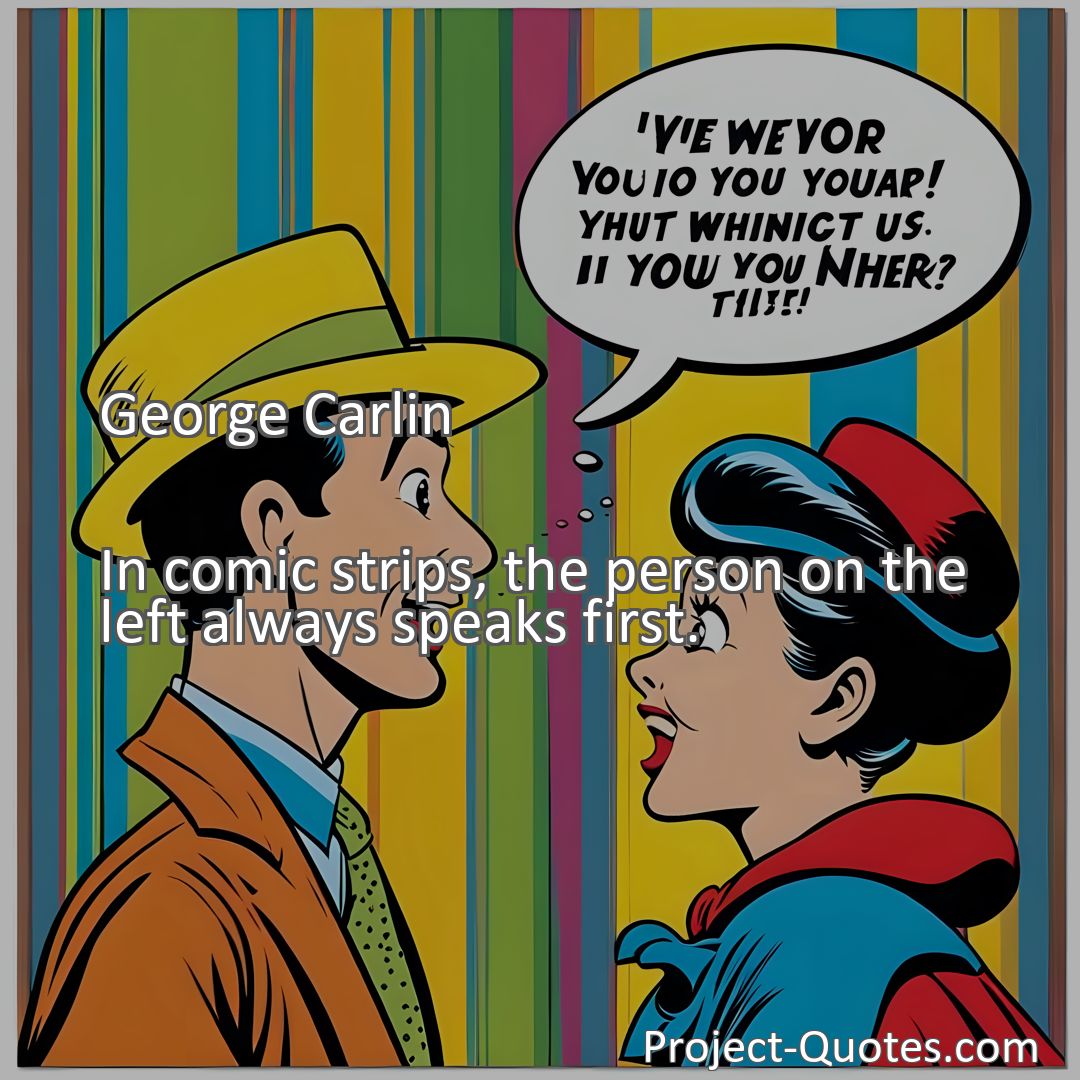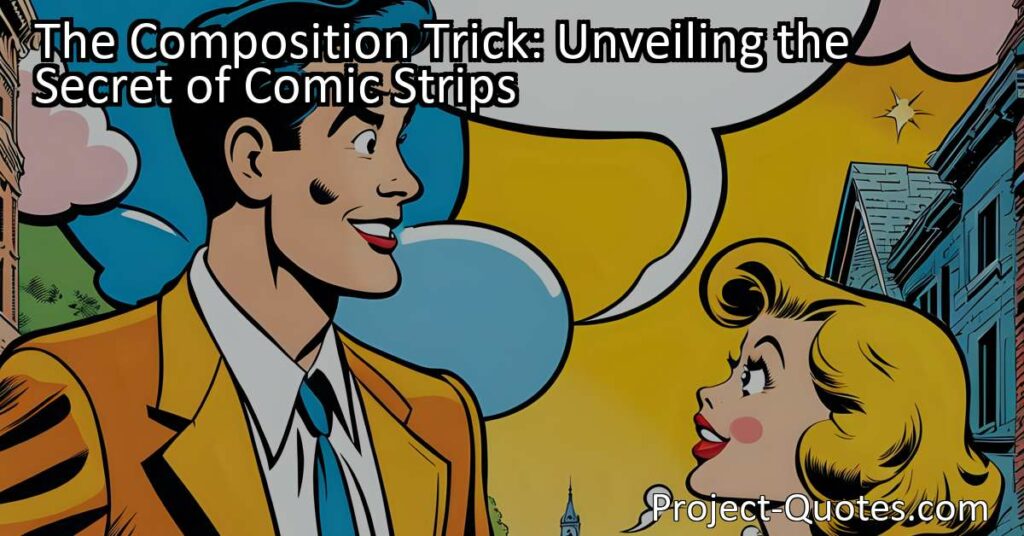In comic strips, the person on the left always speaks first.
George Carlin
Discover the secret behind comic strips with the visual trick called ‘composition’. By arranging characters and speech bubbles from left to right, artists guide our eyes smoothly through the strip and make the story easy to follow. This clever technique, influenced by how we read and process information, adds an extra layer of fun to our comic strip adventure!
Table of Contents
Meaning of Quote – In comic strips, the person on the left always speaks first.
Hey there, friends! Let’s have a fun chat about a hilarious observation made by the legendary comedian George Carlin. He once said, “In comic strips, the person on the left always speaks first.” Now, doesnt that tickle your funny bone? It’s a small detail we hardly notice, but its super interesting once you give it some thought. So, whats the magic behind this little comic strip secret? Lets dive in and explore!
Comic strips are those small, magical worlds tucked away in the corners of newspapers or on cool websites, where funny characters live out their funny lives, one-three panels at a time. But have you ever wondered why things happen the way they do in comics? For starters, why does the person on the left get to kick off the conversation?
Well, it’s all about how we read and process information. In many parts of the world, people read from left to right. This is the natural flow for us, just like grabbing a slice of pizza starts with picking it up and ends with the yumminess hitting our taste buds! Therefore, comic strip artists cleverly arrange their characters and speech bubbles to match this reading direction. It’s like a reading highwaythe first stop is on the left!
When the first talker is on the left, it sets up the scene nicely. Its as though they are inviting us into their comic world; they say, “Hey, check out what’s happening in my day!” And because we read left to right, we can follow their chat just as easily as following the path from our homes to our favorite hangout spot.
Now, lets zoom into the writer’s and artist’s world of creating a comic strip. They’re like the masterminds behind a sneaky plan, always thinking about the best way to tell their short and snappy stories. They ask questions like, “How can I make my readers giggle?” or “Whats the zaniest twist I can throw in today?” And a big part of the answer lies in arranging who talks first and how the conversation flows.
Artists often use a visual trick called composition to guide the readers eyes through the strip. This fancy word just means they are arranging everything in the panel (like the characters, background, and speech bubbles) in a way that feels as smooth as skating on ice. Starting with the left makes it glide better, especially since everything around usfrom books to video gamesusually moves the same way. So, it’s not just comic strips that follow this rule; its kind of a universal thing!
Heres something else to think about: have you ever noticed that time in comics seems to follow the same left to right rule? Take Garfield, for example, that lazy, lasagna-loving cat. If we see him eyeing a pie on the counter in the first panel, and in the next panel its gone, and hes got that cheeky grin, we know exactly what happenedall without seeing him actually gobble it up! Time travels across the strip from left to right, just like it does through the words in a book or when youre binge-watching a show on a lazy Saturday afternoon.
Plus, using the left-to-right trick keeps everything from becoming a jumbled mess. Imagine if speech bubbles were all over the place and you didn’t know who was speaking first. It would be more confusing than trying to understand why superheroes wear their underwear over their pants! By keeping things orderly, comic strips tell us a smooth story in just a few boxes, which is super cool if you think about it.
Now lets have some fun and flip things aroundliterally. What if comics were written for people who read from right to left, like some of our friends across the globe do? In countries like Japan, which is famous for its manga (that’s a super cool word for Japanese comics), everything is mirrored, and the person on the right would likely be the one to start yapping. So, if we were reading a manga version of “Garfield,” we might see him smirking with a full belly before we see the pie on the counter. It’s the same story but flipped around like a pancake on a Sunday morning.
But, no worries, comics are super adaptable, just like we are when trying to solve a tough puzzle or level up in our favorite game. They change direction according to who is reading them, making sure the story is easy to follow no matter which way your reading compass points.
Another bucket of giggles comes from how comic strip writers play with this rule. They might throw us a loopy-loop every now and then by making the character on the right act firstmaybe with a look, a point, or something wild happening like a pie flying across the panel! Its their way of keeping us on our toes, just like when a plot twist in a movie makes everyone gasp.
In just a handful of pictures and words, comic strips have the power to make us laugh, think, and sometimes even feel a little bit sad (but in a good way, like when a story touches our hearts). Their speech bubbles and panels are a dance of timing and order, all to make sure the punchline hits harder than a water balloon on a hot day.
So, the next time you pick up a comic strip, take a moment and notice how its all laid out. Think about why the person on the left is so eager to chat first and why the flow feels just right. Then, give a little nod to the artists and writers who work behind the scenes, piecing together the puzzles that make those comic strip worlds so much fun to visit.
George Carlins quip reminds us that even the smallest details can be a source of joy and laughter. It also shows us the clever thinking that writers and artists put into their work to make our reading experience smooth and delightful. And with this new knowledge, reading comic strips can now be an adventure, unraveling the secrets behind the scenes and enjoying the funniness on the surface even more. After all, isn’t it awesome that there’s a whole world of laughter waiting for us in those little boxes just when we want it?
I hope this quote inspired image brings you hope and peace. Share it with someone who needs it today!


